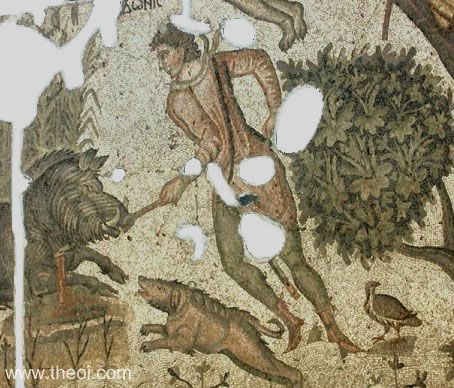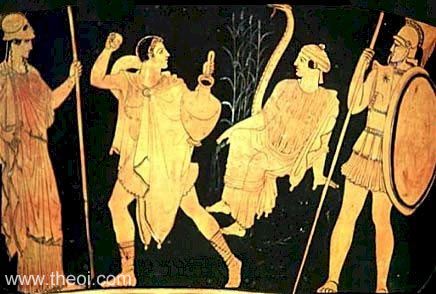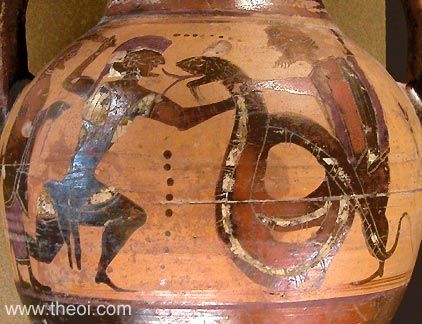ARES WRATH
Greek Name
Αρης
Transliteration
Arês
Latin Spelling
Ares
Translation
Mars

ARES was the Olympian god of war, battlelust and manliness.
This page describes stories of the god's wrath. The most important of these were the tale of his transformation of the hero Kadmos into a serpent and the murder of his daughter Alkippe's rapist Hallirhothios. Compared to the other Olympian gods Ares possessed very few wrath stories--presumably his anger was believed to manifest in the course of war rather than focus on individual offences.
WRATH GENERAL
ADONIS A prince of Kypros (eastern Mediterranean) loved by the goddess Aphrodite. Ares, jealous of their affair, turned himself into a boar and slew the youth. (In other versions of the story it was Artemis who sent the boar).
HALIRRHOTHIOS (Halirrhothius) An Athenian youth (southern Greece) who was murdered by Ares angry at the rape of his daughter Alkippe.
KADMOS (Cadmus) A king of Thebes in Boiotia (southern Greece) who slew the Drakon which guarded the sacred spring of Ares. The god bided his time and when the opportunity presented itself, transformed Kadmos and his wife Harmonia into serpents.
CLASSICAL LITERATURE QUOTES
ARES WRATH : ADONIS
LOCALE : Kypros (Eastern Mediterranean)
Nonnus, Dionysiaca 42. 1 ff (trans. Rouse) (Greek epic C5th A.D.) :
"She [Aphrodite having born a daughter to Adonis] turned her round eyes delighted in all directions; only the boars she would not watch in their pleasures, for being a prophet she knew, that in the shape of a wild boar, Ares with jagged tusk and spitting deadly poison was destined to weave fate for Adonis in jealous madness."
ARES WRATH : HALIRRHOTHIUS
LOCALE : Athens, Attika (Southern Greece)
Pseudo-Apollodorus, Bibliotheca 3. 180 (trans. Aldrich) (Greek mythographer C2nd A.D.) :
"Agraulos [daughter of Kekrops king of Athens] and Ares had a daughter Alkippe. As Halirrhothios, son of Poseidon and a nymphe named Eurtye, was trying to rape Alkippe, Ares caught him at it and slew him. Poseidon had Ares tried on the Areopagos with the twelve gods presiding. Ares was acquitted."
Pausanias, Description of Greece 1. 21. 4 (trans. Jones) (Greek travelogue C2nd A.D.) :
"There is a spring [near the Akropolis, Athens], by which they say that Poseidon's son Halirrhothios deflowered Alkippe the daughter of Ares, who killed the ravisher and was the first to be put on his trial for the shedding of blood."
Pausanias, Description of Greece 1. 28. 5 :
"There is also the Areopagos (Hill of Ares) [at Athens], so named because Ares was the first to be tried here; my narrative has already told that he killed Halirrhothios, and what were his grounds for this act."
Seneca, Hercules Furens 1341 (trans. Miller) (Roman tragedy C1st A.D.) :
"My land [Athens] awaits thee. There Gradivus [Ares] once cleansed his hands from blood [i.e. for the murder of Hallirhothios] and gave them back to war."
Suidas s.v. Areios pagos (trans. Suda On Line) (Byzantine Greek lexicon C10th A.D.) :
"Areios pagos (Areopagus, hill of Ares): A law court amongst the Athenians . . . It was given the name Areios pagos (Hill of Ares) . . . because it tries homicide cases; Ares [has a link] with homicides--or because he grounded his spear there in the suit against Poseidon over Halirrhothios, when [Poseidon] killed [Halirrhothios] because he had raped Alkippe, his daughter with Agraulos the daughter of Kekrops, as Hellanickos says in [book] one."
ARES WRATH : CADMUS

LOCALE : Thebes, Boiotia (Central Greece)
Pseudo-Apollodorus, Bibliotheca 3. 22 (trans. Aldrich) (Greek mythographer C2nd A.D.) :
"[Kadmos] sent some of his men to fetch water from the spring of Ares, but a Serpent, said by some to be a child of Ares, guarded the spring and destroyed most of those who had been sent. In outrage Kadmos killed the Serpent, and then, following the instructions of Athena, planted its teeth. From this sowing there sprang from the earth armed men, called Spartoi . . . As for Kadmos, to atone for the deaths he served Ares as a labourer for an ‘everlasting year,’ for a year then was equal to eight years now. After his period of labour, Athena provided Kadmos with the sovereignty [of Thebes], and Zeus gave him Harmonia, daughter of Aphrodite and Ares, as a wife."
Pseudo-Hyginus, Fabulae 6 (trans. Grant) (Roman mythographer C2nd A.D.) :
"Cadmus along with Harmonia his wife, daughter of Venus [Aphrodite] and Mars [Ares], after their children had been killed, were turned into snakes in the region of Illyria by the wrath of Mars [Ares], because Cadmus had slain the Dracon, guardian of the fountain of Castalia [Hyginus confuses the Ismenian Spring of Thebes with the Kastalian of Delphoi]."
Pseudo-Hyginus, Fabulae 178 :
"While [Cadmus] was seeking water [when he first arrived in Boiotia] he came to the fountain of Castalia, which a Dracon, the offspring of Mars [Ares], was guarding. It killed the comrades of Cadmus, but was killed by Cadmus with a stone. Under Minerva's instructions he sowed the teeth and plowed them under. From them sprang [armed warriors called] the Sparti."
Ovid, Metamorphoses 3. 28 ff (trans. Melville) (Roman epic C1st B.C. to C1st A.D.) :
"He [Kadmos] sent his henchmen forth to find a spring of living water for the ritual [upon his arrival in Boiotia]. There stood an ancient forest undefiled by axe or saw [sacred to Ares], and in its heart a cave close-veiled in boughs and creepers, with its rocks joined in a shallow arch, and gushing out a wealth of water. Hidden in the cave there dwelt a Snake, an Anguis Martius (Snake of Mars) [Ares] . . . [It was slain by Kadmos] Then as the victor contemplates his foe, his vanquished foe so vast, a sudden voice is heard [perhaps Ares], its source not readily discerned, but heard for very sure : ‘Why, Cadmus, why stare at the Snake you've slain? You too shall be a Snake and stared at.’"

Ovid, Metamorphoses 4. 565 ff :
"Cadmus . . . overcome by sorrow and his train of troubles and so many warning signs, he left the city, Thebae, that he had founded, as if that city's fortune, not his own, were crushing him, and with his pilgrim wife, after long wanderings reached Illyria. And now, worn by their woes and weight of years, the two were talking of their early times, the fortune of their house and their said toils, and Cadmus said ‘Was that a sacred Snake my spear transfixed when I had made my way from Sidon's walls and scattered on the soil the Serpent's teeth, those seeds of magic power? If it is he the jealous gods avenge with wrath so surely aimed, I pray that I may be a Snake and stretch along the ground.’
Even as he spoke he was a snake that stretched along the ground. Over his coarsened skin he felt scales form and bluish markings spot his blackened body. Prone upon his breast he fell; his legs were joined, and gradually they tapered to a long smooth pointed tail. He still had arms; the arms he had he stretched, and, as his tears poured down still human cheeks, ‘Come, darling wife!’ he cried, ‘my poor, poor wife! Touch me, while something still is left of me, and take my hand while there's a hand to take, before the whole of me becomes a snake.’
More he had meant to say, but suddenly his tongue was split in tow; words failed his will; and every time he struggled to protest, he hissed; that was the voice that nature left. Beating her naked breast, his wife cried out ‘Stay, Cadmus, stay! Throw off that monstrous shape! Cadmus, what now? Your feet, your shoulders, hands where are they? And your colour and your shape, and, while I'm speaking, everything? Ye Gods, why don't you turn me too into a snake?’
He licked his poor wife's cheeks, and glided down to her dear breasts, as if familiar there, and coiled, embracing, round the neck he knew. All who were there--and courtiers were there--were terrified; but she caressed and stroked her crested dragon's long neck, and then suddenly there were two, their coils entwined. They crawled for cover to a copse nearby; and still, what they once were, they keeping in mind, quiet snakes, that neither shun nor harm mankind."
Suidas s.v. Kadmeia nike (trans. Suda On Line) (Byzantine Greek lexicon C10th A.D.) :
"When Kadmos destroyed the Drakon which guarded the spring of Ares, he laboured for Ares for eight years."
For an ALTERNATE version of this myth see Ares Favour: Cadmus & Harmonia
For MORE information on the Dragon of Thebes see DRAKON ISMENIOS
For MORE information on Ares' daughter Harmonia see HARMONIA
SOURCES
GREEK
- Euripides, Bacchae - Greek Tragedy C5th B.C.
- Herodotus, Histories - Greek History C5th B.C.
- Apollodorus, The Library - Greek Mythography C2nd A.D.
- Strabo, Geography - Greek Geography C1st B.C. - C1st A.D.
- Pausanias, Description of Greece - Greek Travelogue C2nd A.D.
- Nonnus, Dionysiaca - Greek Epic C5th A.D.
ROMAN
- Hyginus, Fabulae - Latin Mythography C2nd A.D.
- Ovid, Metamorphoses - Latin Epic C1st B.C. - C1st A.D.
- Seneca, Hercules Furens - Latin Tragedy C1st A.D.
BYZANTINE
- Suidas, The Suda - Byzantine Greek Lexicon C10th A.D.
BIBLIOGRAPHY
A complete bibliography of the translations quoted on this page.